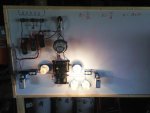A classroom demo was built to represent power from the utility through the service, down to a QO 200 amp panel and out to loads. The board was built to demonstrate open, and resistive connections and the effect on the load that the customer can see. There are parallel circuits using bulbs for load and a series circuit using two 120 volt bulbs served in series with 240. When the loads are balanced and the resistor is cut into the neutral return there is no change in the load. Create an unbalance by bringing on another 120 volt load and the resulting voltage change can be seen with voltmeters and the bright/dimming of the bulbs. All of that was expected.
When the same situation is built with an open neutral the parallel 120 volt bulbs begin to strobe. The series circuit does not. I changed the amount of unbalance drastically and there was no change, the bulbs continued to strobe. This open neutral has no earth reference. When an earth reference is added allowing some neutral current to return, the strobing stops. I haven't seen this before. I can create the strobe every time with the unbalanced 120 volt load and the open neutral. Have a video but haven't converted to a file type yet that will upload.
Can someone offer an explanation for the strobing bulbs?
When the same situation is built with an open neutral the parallel 120 volt bulbs begin to strobe. The series circuit does not. I changed the amount of unbalance drastically and there was no change, the bulbs continued to strobe. This open neutral has no earth reference. When an earth reference is added allowing some neutral current to return, the strobing stops. I haven't seen this before. I can create the strobe every time with the unbalanced 120 volt load and the open neutral. Have a video but haven't converted to a file type yet that will upload.
Can someone offer an explanation for the strobing bulbs?

